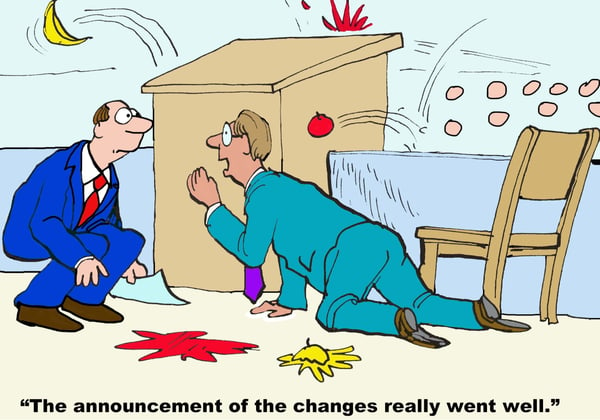In my 40+ years of Change Management Consulting, I’ve seen a lot of resistance to change. In fact, I’d be surprised if someone could come up with an example of resistance I haven’t experienced! To many of my clients, resistance is one of the most frustrating aspects of implementing a business change. But, I’m here to tell you it doesn’t have to be. 
When it comes to implementing an organizational change reluctance to do things in a new way is inevitable. Contrary to popular belief this has nothing to do with how much someone understands or likes the change. Simply put, resistance is a way for people to protect themselves against changes in their job tasks, work behaviors, performance measures, power and/or status. The more the Targets of a change believe their current habits and patterns will be impacted, the more resistance you will see.
So, when it comes to resistance to change the question should not be whether or not you will have it, but rather how much there will be and what strategies you will use to manage it. Below I’ve listed several real-life examples of resistance to change along with a few tips on how to manage them:
Overheard in the break room, “We tried this years ago and it didn’t work."
The unfortunate truth of the matter is resistance is cumulative. This means the resistance you encounter today may, in fact, be due to a change that failed several years ago! Whether leaders recognize it or not, …poorly managed implementations often have a long-term, residual impact.
One of the most powerful tools you can use to manage resistance such as this is involvement. In this example, find out from the Frame of Reference of the person who made the comment why it didn’t work the last time. Then, try enlisting that person to help make it work this time. Remember, even if you can’t get people involved in deciding what to change, you can almost always get them involved in how to change it.
Surprisingly the lower levels of the organization are fine, it’s the managers who are resisting the change!
One of the fundamental principles of the AIM Change Management Methodology is to expect the highest level of resistance from the people that have the greatest motivation for things to remain the same. Who has the greatest investment in things remaining at status quo? Mid-to upper-level managers do! Because in the end, they are the ones who have the most to lose in terms of current and future power and prestige.
This is why I always say, it is critical to treat every level of the organization, from the senior leadership down, as Targets first. There is absolutely no point in trying to create readiness at the lower levels of the organization if the people in power are resisting the change. Instead, readiness needs to be cascaded through the organization level by level.
This change is making things better, everyone should love it! So, why in the world is there still resistance?
An important point to remember during any change, whether it is perceived as negative or positive, is that different people will have different reactions to it. The truth is… what's positive to you or your senior leaders may not be so positive to the Targets of the change. From their Frame of Reference, the change may create a lot of uncertainty and disruption.
There are various methods to diagnostically measure the level of disruption from the Frame of Reference of each Target. The easiest (and most often overlooked) technique is simply asking questions and then listening to the answers. Radical, right!?! Other methods include (but are not limited to):
- Focus groups
- E-Surveys
- Team Meetings
- Q&A Sheets
- Hot Lines
No matter what technique you use, remember no communication should go out without a feedback loop attached to it. It’s an excellent way to gather information about sources of resistance to the change.
Resistance? What resistance?
If you assume just because you aren’t hearing or seeing resistance, it's not there, you are making a huge mistake! Often resistance is covert rather than overt, but it is still resistance! In fact, you should be more concerned when the resistance is underground because it’s very difficult to manage something you can’t see! The task of a Change Agent is to bring this resistance out into the open and then manage it!
As I’m sure you know, these examples are just a few of the countless types of resistance you can face during an organizational change. The good news is… resistance is not all bad! It’s a natural part of the change process and can actually be a sign of organizational health! If it is purposefully managed, resistance can be seen as project feedback and can be used to increase communication, promote genuine involvement, build resiliency and create opportunity for buy in.
So now I ask, are you going through a business change? What types of resistance are you seeing? And maybe more importantly, what are you doing to manage it?


